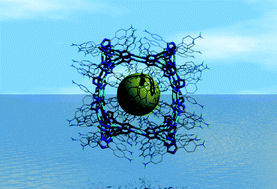A microporous cationic metal–organic framework constructed from metallamacrocycle-based nanocages: structures and luminescence properties†
Abstract
A novel metal–organic framework (MOF) {[CuI13(L1)10]·(OH)3(H2O)3}∞ (1) has been fabricated through in situ copper-mediated ring conversions of 2,5-bis(4-amidophenyl)-1,3,4-oxadiazoles into 3,5-bis(4-amidophenyl)-1,2,4-triazolate under hydrothermal conditions. The most aesthetically fascinating structural feature of 1 is the host cationic microporous metal–organic framework constructed from unique indiscrete polyhedral [Cu32(L1)28] nanocages. Interestingly, the cage is composed of three different kinds of two-fold symmetry related polynuclear metallamacrocycles (MMCs): octanuclear rhombus-like, dodecanuclear boat-shaped, and dodecanuclear square-like MMCs. These cages are arranged into 1-D square-like channels with an effective dimension of ~5.9 × 4.4 Å, viewed along the a-axis, occupied by uncoordinated water molecule and OH− anions, hydrogen bonded to the terminal NH2 groups of the L1 ligands. Additionally, from the topology views, considering the propeller-shaped [Cu3(L1)5] moiety as a secondary building unit (SBU1), it adopts a non-interpenetrating 5-connected uninodal 3-D network; but if regarding the [Cu8(L1)10] as a SBU2 generated from two SBU1 connected by two Cu5, it adopts a non-interpenetrating 6-connected uninodal α-Po 3-D network. Moreover, the luminescence spectra show that it exhibits yellow-green fluorescence with a broad emission band peaked at 536 nm upon photoexcitation at 389 nm.


 Please wait while we load your content...
Please wait while we load your content...